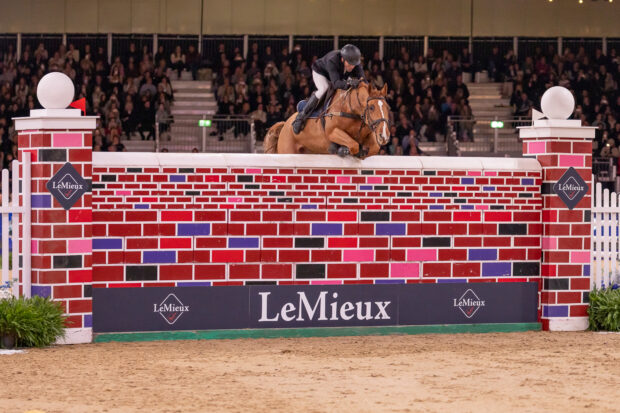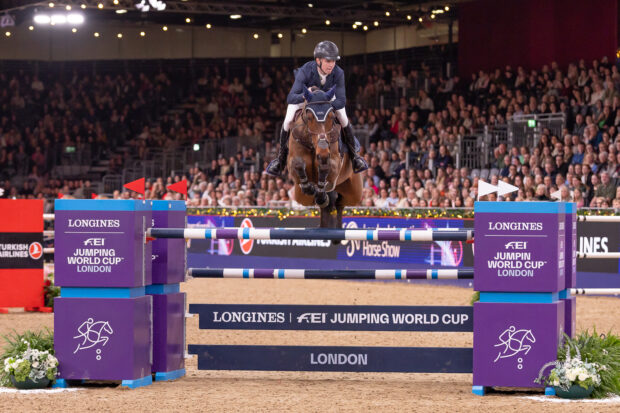It takes practice at home to perfect the art of jumping in indoor arenas. Graham Fletcher explains how to get the best results from your horse
Indoor shows are the best place to start jumping novices. Not only is good going guaranteed, but the enclosed ring helps their concentration.
These venues tend to have limited space for warming up, but you can get round this by working the horse at home first, or arriving early before the collecting ring becomes too crowded.
In the ring, fences come up very quickly. Distances are related and there is little room to set yourself up after a corner, so the horse needs to be really obedient.
Using bounces
Although bounces are not used in show jumping competitions, they are useful for training as they promote suppleness and athleticism, as well as teaching the horse to spring off his hocks.
Begins with a placing pole on the floor, followed 3yd later by a small cross-pole. Once the horse has jumped this three or four times, add another cross-pole 3«yd away to create a bounce. Later, a second bounce can be added, 3«yd from the first.
Using cross-poles keeps the horse straight, essential when jumping indoors. The crosses can gradually be made higher as the horse gains confidence. A steep cross encourages him to snap up in front by using his shoulders.
This exercise is fairly hard work, so should be built up to gradually and finished while the horse is still enthusiastic.
Bounce distances also help to improve the rider’s position in a situation where fences come round quickly. A common fault is to tip the body forward going to a fence, so the idea here is to bring the body back into position on each bounce. Keeping your head up and looking forward will make it easier, but it is important to give with the hands as the horse jumps.The rider’s legs should remain still, squeezing as the horse takes off each time, with your weight staying deep in the stirrups.
Placing poles
Ridden in canter, placing poles can help recreate a typical double combination coming a short distance off a corner. The placing pole is positioned two non-jumping strides (10yd) from the first obstacle.
A two-stride placingpole helps riders to keep a rhythm and find a stride. There is no room indoors to spend ages setting up a stride, so rhythm is vital, as is riding positively if you arrive a bit long or deep.
The 7yd distance between the elements of this double isslightly shorter than the usual 8yd found in competition. This encourages the horse to snap up his front legs and make a rounded, arc-like shape, rather than jump long and flat.
I would usually begin this exercise with two small verticals, converting the second to an oxer as the horse gains confidence. How big you go depends on his experience, but height is not as important as control, accuracy and riding position.
The second placing pole comes on a bounce stride 4yd after the final fence. This gets the horse to drop his head and neck and helps him concentrate and land on the correct leg for the next fence.
Having completed this exercise, don’t let the horse tear off round the corner. Sit up, gather him between hand and leg andride the corner with controlled impulsion.Having cantered properly halfway round the school, then pull up and give the horse a pat.
With a short approach to a mass of poles, this exercise is also good practice for riding against the clock indoors. With no room to gallop, time must be made up on turns with the emphasis on keeping a rhythm. Keeping your eye on the next fence as you ride each turn is a good tip.
Don’t cut corners
Despite lack of space indoors, top professionals manage to flow on in a good, positive rhythm.
The secret is to use every inch of the ring, particularly the corners. “Motorbiking” turns, with the horse’s body falling in and his head turned to the outside, loses valuable strides.
Work on turns at home, even in the corner of the field. Ask the horse to bend round your inside leg as you give and take with the inside rein and offer support with the outside hand.
Obviously, you should always come off a corner on the correct canter lead, and this should be established before going into a turn – even if it means bringing a novice back to trot.
Asking for canter strike-off over a pole on the ground often helps, while a pole incorporated into the centre of a figure of eight can be used to encourage a flying change.
As you come out of a corner, it is invaluable to be able to lengthen or shorten your stride. Use half halts to get the horse “listening” to your hand and leg.
Surviving indoors
- Hire a school before the horse’s first show, get a group together to save money, or book a lesson with someone who has a school.
- Take plenty of rugs, and throw one on as soon as the horse has finished jumping; there is nowhere colder than an indoor show on a January evening.
- Arrive early to work-in before the collecting ring gets too crowded, or work-in at home.
- Take a helper to put up the practice fence for you. Start with a small cross-pole from trot.
- Keep the horse walking about while he waits. Hanging about near the in-gate is asking for him to nap when it is his turn to jump.
- Novices are always that bit spookier and stuffier indoors, so be prepared to ride positively.
- Use an early clear round class for a warm-up and to let your horse see the arena.
- Take hay and water – indoor classes can be long. Keep the horse happy, so he will enjoy the outing and go well next time.



